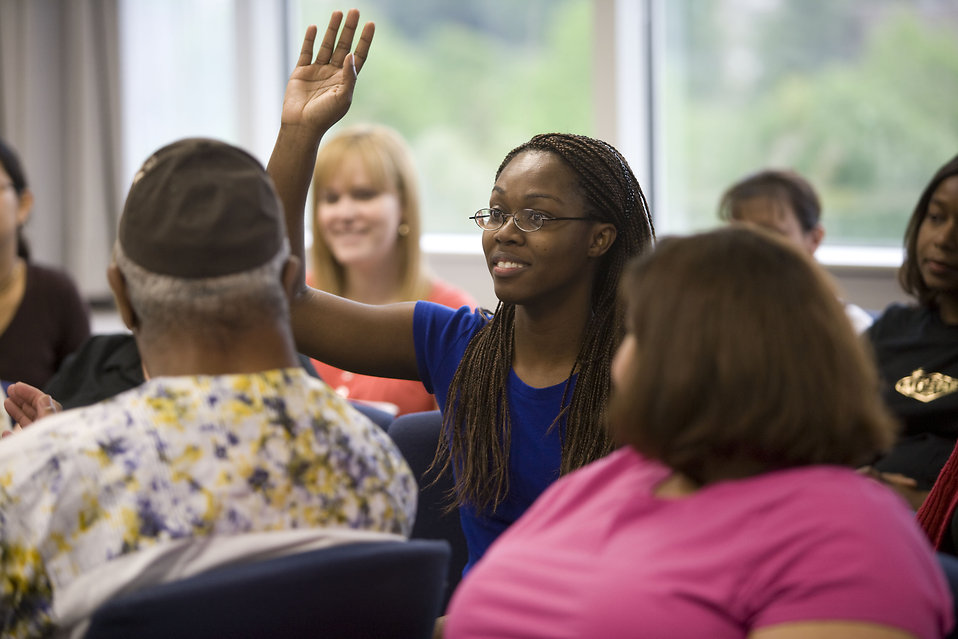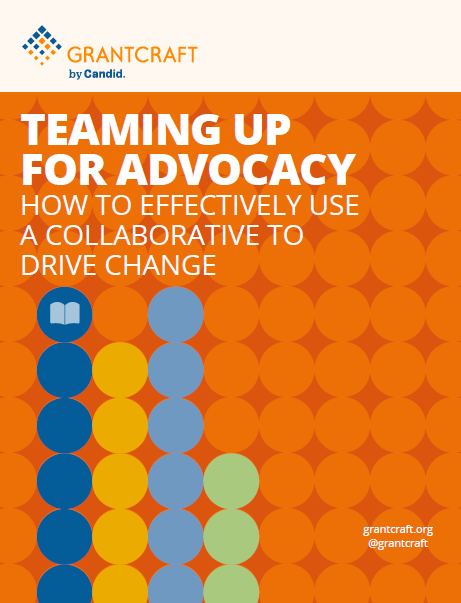What Are the Benefits of Being Part of an Advocacy Collaborative?
Grantmakers were remarkably consistent about the benefits of participating in advocacy collaboratives. These were:
- Accessing knowledge from all kinds of experts, especially groups working on the front lines. It’s not unusual for funders to come into an advocacy collaborative knowing little about an issue. But they soon get the chance to learn directly from people with deep expertise—their colleagues, field leaders, and other experts. That’s knowledge “a lot of funders probably wouldn’t be able to access on their own and that leads to smarter grantmaking.”
Members’ institutions benefit from this expertise as well. Having access to “an ever-expanding grantee and funder network, along with other experts in the field, is a quick and easy way to radically expand what I bring into my own institution’s grantmaking without having to expand our staff.”
Expert intelligence also helps members spot trends and opportunities, find funding partners, and, together, act on information more effectively. Being able to get this information “at any given time is no small feat because these issues are often complex. I think responsible grantmakers build a lot of relationships—sometimes more than one person can hold—so having different points of reference helps you see partnership opportunities.”
Funders agree that one of the most valuable aspects of being part of advocacy collaboratives is that they’re better able to “see the bigger picture” and where their perspective or theory of change might fit within a more comprehensive advocacy strategy. “I’ve seen program officers come into a collaborative feeling as if they know everything about a particular issue because they were hired by their institution for that expertise. What they quickly find is that their perspective is one of several.” For many grantmakers, this is new and humbling; it’s easy to thrive on individual expertise. But, among others with valuable knowledge, the group mentality quickly shows its value. “Being part of a community of donors who are open to new ideas helps them see themselves in the work.”

- Making investments and connections beyond what would be possible through their own foundations. Advocacy collaboratives often give grantmakers a way to make investments they may be unable to make as individual program officers, due to mission, urgency, defined program areas and investment strategies, governance, or other structures. “The most meaningful advances for our constituency take place at the local level, where the collaborative I participate in has helped build a movement. As a national foundation, we aren’t able to directly support that work, but the collaborative allowed us to go beyond our foundation’s constraints and do something we couldn’t do on our own.”
Policy change windows and funding needs can emerge quickly, in unanticipated ways, and with little prior notice. Fellow grantmakers from institutions with extensive procedures and layers of bureaucracy agree that being part of an advocacy collaborative makes it more possible for them to “move the money more quickly and in more targeted ways” than they can do individually. “It gives us a nimble way to react and is a great adjunct to the core support our foundation has traditionally given to the big human rights and civil liberties groups.”
One grantmaker’s foundation had quarterly cycles that required grants to be made in advance, most of which were large multi-year allocations, because the board wanted to see “big bets” and didn’t want make a lot of small, short-time grants they felt would get them into the weeds. In many contexts, this is a valuable investment strategy. However, to every strong strategy, there’s a downside. “We wanted to be policy funders, and that meant we had to find a way to give those kinds of rapid response grants. The funder collaborative we joined helped us do that.”
Advocacy collaboratives can also give program officers a broader network of resources, more direct connection with the people they support, or with other communities affected by the foundation’s work. “A lot of foundations don’t have program officers who have direct experience working with Muslims, even though Islamophobia affects every issue we work on. If I’m working with an advocacy collaborative that has connections to that community or a program officer from that community, it educates me.”
- Leveraging and bringing to scale their foundations’ investments. Many grantmakers join advocacy collaboratives because their institutions can be more effective and have more impact collectively than individually. A donor whose collaborative now funds in 30 states points out that there was “just no way that I, as a national funder, could ever do this on my own well. Even though we’re a big foundation, we just don’t have the capacity.” Funders who join advocacy collaboratives tend to recognize their foundation’s limitations in supporting advocacy well, at scale in the real world, and so collaboratives are a way to join forces with like-minded funders to jointly move advocacy investments effectively and at scale.
Moreover, the public policy issues that advocacy funders deal with are usually bigger and more complex than one institution can handle alone, so collaboratives give grantmakers the chance to work with other funders with the same goals—“a system that’s much more cost effective.” Having extra sets of eyes, as well as checks and balances, doesn’t hurt either.
Small foundations, in particular, benefit from participating by amplifying their voices. “We’re only able to give a small amount of money to the collaborative’s grantmaking pool, but we still get to vote on how millions of dollars in that pool are allocated. We’re getting a lot of leverage being associated with these large amounts of money!”
Collaboratives also help provide additional services for grantees such as capacity building, technical assistance, and peer learning convenings—the kinds of “things individual funders like me can’t or don’t do but are critical to sustaining this work.” Collaboratives that are staffed, for example, “can put together a docket that would take me years to be as competent in that space. And they also give the grantees help in marketing and communications. I want all that as part of my strategy!”
Finally, collaboratives can help sustain advocacy work. “For our foundation, the advocacy collaborative was a way to help build up the financial support for these issues by working with and continually finding other funding partners to make sure that when we left, there would still be other funders in that space.” Joining forces puts a stake in the ground to say that philanthropic support for a given issue isn’t going to go away, even when approaches and investments at individual foundations might shift.
-
Improving grantmaking practice that builds the capacity of foundations and their leaders themselves. Advocacy funders say collaboratives improve their grantmaking in powerful ways. They help program officers strategically map what’s going on in the field, identify gaps, and think more deeply about how their institutional funding can best fill those needs. “Our advocacy collaborative functions as an efficient team where we think about who’s doing what in this small network of deep-pocket funders and learn where everyone’s funding. Then, as a group, we figure out where to plug those holes so we don’t duplicate what’s already sufficiently resourced. The collaborative construct and the people who staff it allow us to do this really well.” For organizations and staff that may not spend time independently scanning, it is baked into how collaboratives must operate.
Individual funders also believe their grantmaking is improved because the information shared through the advocacy collaborative is more comprehensive, timely, and rich. “When I first got into philanthropy, I didn’t know what I didn’t know. I was thinking more about individual grantees that had interesting theories of change or were doing appealing work. When I joined the advocacy collaborative, I saw what other people were funding and why, how their strategies were different, and how they were viewing the issue. That led me to a more nuanced view of what my strategy could look like and then shape it in a way that dovetails with others without being duplicative.”
Being part of an advocacy collaborative also opens funders’ eyes to other options and opportunities. “If I were doing this grantmaking on my own, I’d miss important pieces about my issue. For example, I knew a lot about immigration, but I’d never thought about how it intersects the LGBTQ community or the law enforcement aspects of this issue. Now I get it because my colleagues have been so helpful in educating me about it.”
NOW REFLECT:
-
What do you hope to get out of advocacy work that you can only do in partnership with other funders? What’s the value add of your participation (or potential membership)?
-
If you’re not getting the benefits you anticipated, why not? Are there ways to engage other collaborative members in finding ways to address this?
-
How do you talk about the benefits to other staff at your foundation? To trustees? Do they understand? If not, are there ways to strengthen your case?
FURTHER READING:
Please click here for information on GrantCraft's methodology for this research.


